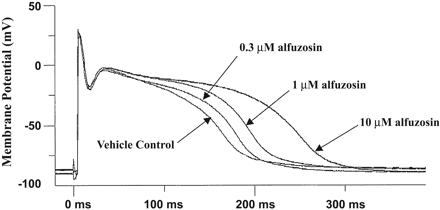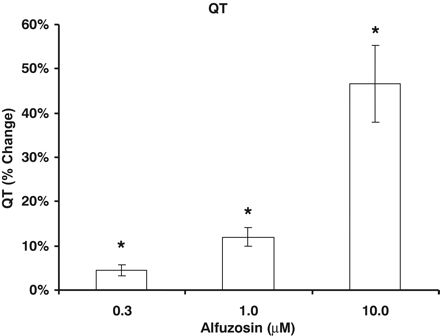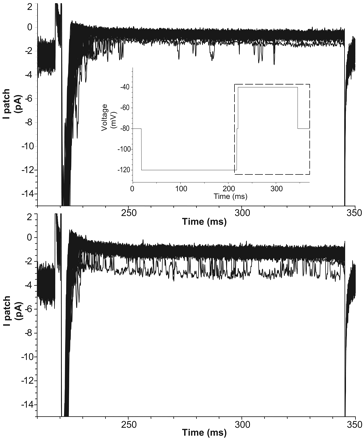
| Size | Price | Stock | Qty |
|---|---|---|---|
| 50mg |
|
||
| 100mg |
|
||
| 250mg |
|
||
| 500mg |
|
||
| 1g |
|
||
| Other Sizes |
|
Purity: ≥98%
Alfuzosin HCl (Alfetim; alfusozine; SL-77499; alphuzosine; Benestan; Urion; UroXatral; Xatral), the hydrochloride salt of alfuzosin, is an approved/marketed drug which acts as an alpha1 adrenergic receptor antagonist. It is authorized for use in the management of BPH, or benign prostatic hyperplasia.
| Targets |
α1-adrenergic receptor
|
||
|---|---|---|---|
| ln Vitro |
|
||
| ln Vivo |
|
||
| Animal Protocol |
|
||
| References | |||
| Additional Infomation |
Alfuzosin Hydrochloride is the hydrochloride salt of alfuzosin, a quinazoline compound with smooth muscle-relaxing activity. Alfuzosin selectively binds to and antagonizes post-synaptic alpha-1-adrenoreceptors in smooth muscle of the prostate, bladder base, bladder neck, prostatic capsule, and prostatic urethra, initiating relaxation of smooth muscle and resulting in improvement of urine flow and the symptoms of benign prostatic hyperplasia (BPH). This agent also blocks alpha-1-adrenoreceptors in peripheral vascular smooth muscle, resulting in vasodilatation and a decrease in peripheral vascular resistance.
See also: Alfuzosin (has active moiety). |
| Molecular Formula |
C19H28CLN5O4
|
|
|---|---|---|
| Molecular Weight |
425.91
|
|
| Exact Mass |
425.182
|
|
| Elemental Analysis |
C, 58.60; H, 6.99; N, 17.98; O, 16.43
|
|
| CAS # |
81403-68-1
|
|
| Related CAS # |
Alfuzosin; 81403-80-7; Alfuzosin-d7 hydrochloride; 1276197-14-8
|
|
| PubChem CID |
71764
|
|
| Appearance |
White to off-white solid powder
|
|
| Density |
1.272 g/cm3
|
|
| Boiling Point |
687.7ºC at 760 mmHg
|
|
| Melting Point |
225°C
|
|
| LogP |
3.124
|
|
| Hydrogen Bond Donor Count |
3
|
|
| Hydrogen Bond Acceptor Count |
8
|
|
| Rotatable Bond Count |
8
|
|
| Heavy Atom Count |
29
|
|
| Complexity |
511
|
|
| Defined Atom Stereocenter Count |
0
|
|
| SMILES |
Cl.O=C(C1CCCO1)NCCCN(C)C1N=C2C(C=C(C(=C2)OC)OC)=C(N)N=1
|
|
| InChi Key |
YTNKWDJILNVLGX-UHFFFAOYSA-N
|
|
| InChi Code |
InChI=1S/C19H27N5O4.ClH/c1-24(8-5-7-21-18(25)14-6-4-9-28-14)19-22-13-11-16(27-3)15(26-2)10-12(13)17(20)23-19;/h10-11,14H,4-9H2,1-3H3,(H,21,25)(H2,20,22,23);1H
|
|
| Chemical Name |
N-[3-[(4-amino-6,7-dimethoxyquinazolin-2-yl)-methylamino]propyl]oxolane-2-carboxamide;hydrochloride
|
|
| Synonyms |
|
|
| HS Tariff Code |
2934.99.9001
|
|
| Storage |
Powder -20°C 3 years 4°C 2 years In solvent -80°C 6 months -20°C 1 month Note: Please store this product in a sealed and protected environment, avoid exposure to moisture. |
|
| Shipping Condition |
Room temperature (This product is stable at ambient temperature for a few days during ordinary shipping and time spent in Customs)
|
| Solubility (In Vitro) |
|
|||
|---|---|---|---|---|
| Solubility (In Vivo) |
Solubility in Formulation 1: ≥ 2.08 mg/mL (4.88 mM) (saturation unknown) in 10% DMSO + 40% PEG300 + 5% Tween80 + 45% Saline (add these co-solvents sequentially from left to right, and one by one), clear solution.
For example, if 1 mL of working solution is to be prepared, you can add 100 μL of 20.8 mg/mL clear DMSO stock solution to 400 μL PEG300 and mix evenly; then add 50 μL Tween-80 to the above solution and mix evenly; then add 450 μL normal saline to adjust the volume to 1 mL. Preparation of saline: Dissolve 0.9 g of sodium chloride in 100 mL ddH₂ O to obtain a clear solution. Solubility in Formulation 2: ≥ 2.08 mg/mL (4.88 mM) (saturation unknown) in 10% DMSO + 90% (20% SBE-β-CD in Saline) (add these co-solvents sequentially from left to right, and one by one), clear solution. For example, if 1 mL of working solution is to be prepared, you can add 100 μL of 20.8 mg/mL clear DMSO stock solution to 900 μL of 20% SBE-β-CD physiological saline solution and mix evenly. Preparation of 20% SBE-β-CD in Saline (4°C,1 week): Dissolve 2 g SBE-β-CD in 10 mL saline to obtain a clear solution. View More
Solubility in Formulation 3: ≥ 2.08 mg/mL (4.88 mM) (saturation unknown) in 10% DMSO + 90% Corn Oil (add these co-solvents sequentially from left to right, and one by one), clear solution. |
| Preparing Stock Solutions | 1 mg | 5 mg | 10 mg | |
| 1 mM | 2.3479 mL | 11.7396 mL | 23.4791 mL | |
| 5 mM | 0.4696 mL | 2.3479 mL | 4.6958 mL | |
| 10 mM | 0.2348 mL | 1.1740 mL | 2.3479 mL |
*Note: Please select an appropriate solvent for the preparation of stock solution based on your experiment needs. For most products, DMSO can be used for preparing stock solutions (e.g. 5 mM, 10 mM, or 20 mM concentration); some products with high aqueous solubility may be dissolved in water directly. Solubility information is available at the above Solubility Data section. Once the stock solution is prepared, aliquot it to routine usage volumes and store at -20°C or -80°C. Avoid repeated freeze and thaw cycles.
Calculation results
Working concentration: mg/mL;
Method for preparing DMSO stock solution: mg drug pre-dissolved in μL DMSO (stock solution concentration mg/mL). Please contact us first if the concentration exceeds the DMSO solubility of the batch of drug.
Method for preparing in vivo formulation::Take μL DMSO stock solution, next add μL PEG300, mix and clarify, next addμL Tween 80, mix and clarify, next add μL ddH2O,mix and clarify.
(1) Please be sure that the solution is clear before the addition of next solvent. Dissolution methods like vortex, ultrasound or warming and heat may be used to aid dissolving.
(2) Be sure to add the solvent(s) in order.
| NCT Number | Recruitment | interventions | Conditions | Sponsor/Collaborators | Start Date | Phases |
| NCT00576823 | Completed | Drug: Alfuzosin | Neurogenic Bladder Hydronephrosis |
Sanofi | December 2007 | Phase 3 |
| NCT00696761 | Completed | Drug: Alfuzosin | BPH | Asan Medical Center | May 2006 | Phase 4 |
| NCT00893113 | Completed | Drug: Alfuzosin Drug: Placebo |
Lower Urinary Tract Symptoms Erectile Dysfunction |
Chesapeake Urology Research Associates |
June 2009 | Phase 3 |
| NCT00575913 | Completed | Drug: Alfuzosin | Prostatic Diseases | Sanofi | September 2003 | Phase 4 |
| NCT02266537 | Completed | Drug: Alfuzosin Drug: Doxazosin |
Healthy | Boehringer Ingelheim | November 2005 | Phase 1 |
 |
|---|
 |
 |